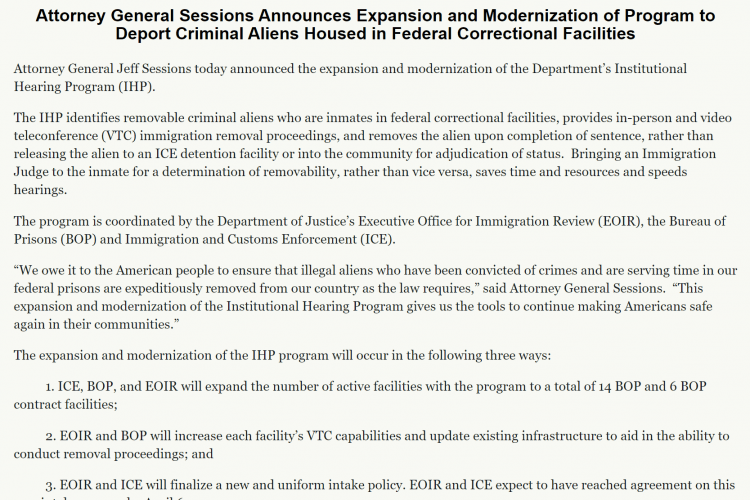Guest post by Ingrid Eagly, Professor, UCLA School of Law and Steven Shafer, Managing Attorney, Esperanza Immigrant Rights Project.

A sustained focus on immigrant detention and deportation has led to the creation of a little-known immigration court system built inside carceral facilities throughout the United States. Referred to as the Institutional Hearing Program or IHP, this court adjudicates the deportation cases of immigrants held in federal or state prisons, as well as local jails. Under the Trump administration, a renewed focus was placed on expanding and growing the IHP.

In a new article published in the Law and Society Review, we examine the origin, growth, and use of the IHP. Our study relied on diverse sources of information, including government memoranda and reports, legislative history, and other historic records. We also analyzed of over forty years of immigration court data.
Our research yields three main findings. First, we show how the IHP operates to convert carceral spaces into sites of both imprisonment and immigration detention. Reviewing historical records, we trace the program’s origin to 1980 when it began as an ad hoc experiment to hold immigration court hearings for Cuban refugees held inside an Atlanta federal prison for purposes of civil detention.

The U.S. Penitentiary in Atlanta where the first IHP hearings were held in the early 1980s (U.S. Bureau of Prisons)
https://en.wikipedia.org/wiki/United_States_Penitentiary,_Atlanta#/media/File:AtlantaUSPnewpic.jpg
Subsequently, laws passed in 1986 and 1988 formally established the IHP as a national program to facilitate the rapid deportation of immigrants serving criminal sentences. Over the forty years of its operation, the program has expanded into state and federal prisons, as well as local municipal jails. The IHP has been most active within five states: California, Florida, Illinois, New York, and Texas. Relying on immigration court data, we find that today’s IHP operates today in twenty-three federal prisons, nineteen state prison systems, and a few municipal jails.

Second, our paper analyzes how the IHP has shaped and reorganized the institutional design of participating prisons and jails. Prisons, for example, have been physically redesigned to make way for immigration courtrooms, bed space dedicated to non-citizens, and offices for immigration agents. The IHP’s immigration enforcement goals have also led participating institutions to engage in residential segregation by citizenship, national origin, and race.
Third, we argue that the IHP has operated as an influential, yet overlooked, incubator of changes in immigration law and practice. These changes include holding court hearings over a video screen (rather than in-person), engaging in jail-based immigration screening, and deporting unrepresented immigrants through stipulated agreements (without ever seeing a judge).
By focusing our research on the IHP, we hope to place these little-known immigration courts into the ongoing discussions related to border criminology.
Any comments about this post? Get in touch with us! Send us an email, or post a comment here or on Facebook. You can also tweet us.
__________
How to cite this blog post (Harvard style)
Eagly, I. and Shafer, S. (2021). Prison-Based Immigration Courts in the United States. Available at: https://www.law.ox.ac.uk/research-subject-groups/centre-criminology/centreborder-criminologies/blog/2021/07/prison-based [date]
Share:








